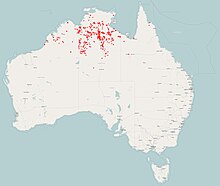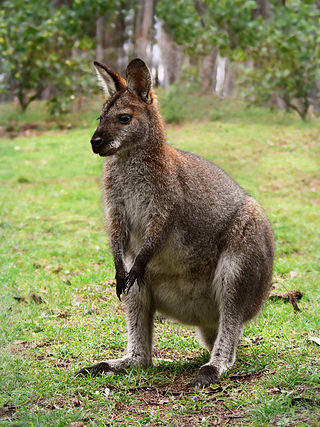
A wallaby is a small or middle-sized macropod native to Australia and New Guinea, with introduced populations in New Zealand, Hawaii, the United Kingdom and other countries. They belong to the same taxonomic family as kangaroos and sometimes the same genus, but kangaroos are specifically categorised into the four largest species of the family. The term "wallaby" is an informal designation generally used for any macropod that is smaller than a kangaroo or a wallaroo that has not been designated otherwise.
Taunton National Park is situated near the town of Dingo approximately 135 km inland from Rockhampton in eastern Central Queensland, Australia. The park encompasses an area of 11,626 ha within the Northern Brigalow Belt bioregion of Queensland; a region widely recognised to contain considerable biodiversity.
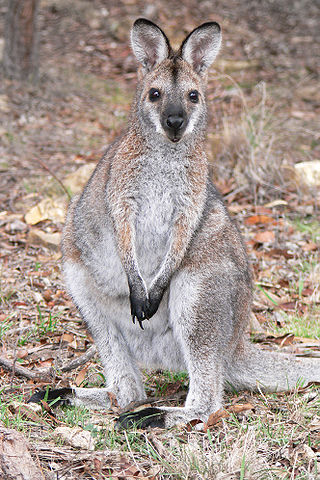
Macropodidae is a family of marsupials that includes kangaroos, wallabies, tree-kangaroos, wallaroos, pademelons, quokkas, and several other groups. These genera are allied to the suborder Macropodiformes, containing other macropods, and are native to the Australian continent, New Guinea and nearby islands.
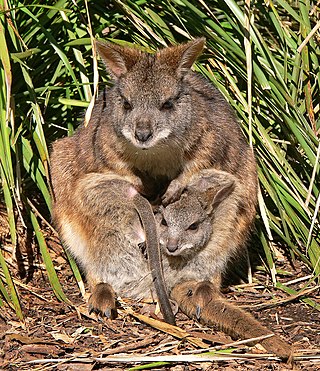
The parma wallaby is a small marsupial macropod mammal native to forests and densely-vegetated areas of northeastern New South Wales, Australia, close to the border with Queensland. There is also an introduced population found in and around Rodney District, just north of Auckland, New Zealand. About the size of a stout cat, it lives mainly under thick plant cover, and is only active at night when it emerges to feed on grasses and small plants. It is the smallest of the wallabies and carries its young in a pouch, as with other marsupials. Shy and elusive, it was believed extinct until its rediscovery in the 1960s.

The tammar wallaby, also known as the dama wallaby or darma wallaby, is a small macropod native to South and Western Australia. Though its geographical range has been severely reduced since European colonisation, the tammar wallaby remains common within its reduced range and is listed as "Least Concern" by the International Union for Conservation of Nature (IUCN). It has been introduced to New Zealand and reintroduced to some areas of Australia where it had been previously extirpated. Skull variations differentiate between tammar wallabies from Western Australia, Kangaroo Island, and mainland South Australia, making them distinct population groups.
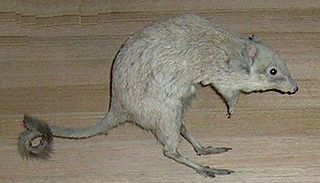
Potoroidae is a family of marsupials, small Australian animals known as bettongs, potoroos, and rat-kangaroos. All are rabbit-sized, brown, jumping marsupials and resemble a large rodent or a very small wallaby.

The bridled nail-tail wallaby, also known as the bridled nail-tailed wallaby, bridled nailtail wallaby, bridled wallaby, merrin, and flashjack, is a vulnerable species of macropod. It is a small wallaby found in three isolated areas in Queensland, Australia, and whose population is declining. In early 2019 the total population of the species was estimated to be fewer than 500 mature individuals in the wild and 2285 in captivity.

The crescent nail-tail wallaby, also known as the worong, was a small species of marsupial that grazed on grasses in the scrub and woodlands of southwestern and central Australia. They were common in Western Australia before they disappeared in the early 20th century and persisted in the central deserts until at least the 1950s. The pelage was soft and silky and an ashen grey colouring overall, highlighted in part with rufous tones. There were light and dark patches of fur across the body, the moon-like crescents inspiring their names, and had attractive stripes on the face. Like the two remaining species of the genus, the northern Onychogalea unguifera and rare O. fraenata, it had a horny spur at the tip of its tail. The species was compared to a hare or rabbit, in its habits, appearance and taste, and weighed around 3.5 kilograms.

The swamp wallaby is a small macropod marsupial of eastern Australia. This wallaby is also commonly known as the black wallaby, with other names including black-tailed wallaby, fern wallaby, black pademelon, stinker, and black stinker on account of its characteristic swampy odour.

The boodie, also known as the burrowing bettong or Lesueur's rat-kangaroo, is a small, furry, rat-like mammal native to Australia. Once common throughout the continent, it is now restricted to a few coastal islands. A member of the rat-kangaroo family (Potoroidae), it lives in burrows and is active at night when it forages for fungi, roots, and other plant matter. It is about the size of a rabbit and, like most marsupials, carries its young in a pouch.

The western brush wallaby, also known as the black-gloved wallaby, is a species of wallaby found in the southwestern coastal region of Western Australia. The wallaby's main threat is predation by the introduced red fox. The IUCN lists the western brush wallaby as Least Concern, as it remains fairly widespread and the population is believed to be stable or increasing, as a result of red fox control programs.

The antilopine kangaroo, also known as the antilopine wallaroo or the antilopine wallaby, is a species of macropod found in northern Australia: in Cape York Peninsula in Queensland, the Top End of the Northern Territory, and the Kimberley region of Western Australia. It is a locally common, gregarious grazer.

The black wallaroo, also known as Woodward's wallaroo, is a species of macropod restricted to a small, mountainous area in Arnhem Land, Northern Territory, Australia, between South Alligator River and Nabarlek. It classified as near threatened, mostly due to its limited distribution. A large proportion of the range is protected by Kakadu National Park.

The nail-tail wallabies, of genus Onychogalea, are three species of macropods, all found in Australia. Related to kangaroos and wallabies, they are smaller species distinguished by a horny spur at the end of their tail. The northern nail-tail wallaby is still common in the northern part of Australia, the crescent nail-tail is now extinct, and the bridled nail-tail is considered rare and endangered, with probably fewer than 1100 mature individuals in the wild. Nail-tail wallabies are smaller than many other wallabies.

Nabarleks, are a tiny species of macropod found in northern Australia. They are a shy and nocturnal animal that resides in rocky hollows and forages in the surrounding area. Their diet is grasses, sedges, and ferns found in and around their scrub covered refuges. They are distinguished by a reddish tinge to the mostly grey fur and a distinct stripe at the cheek. They move with great speed and agility when observed, with a forward leaning posture and a bushy tail that arches over the back.
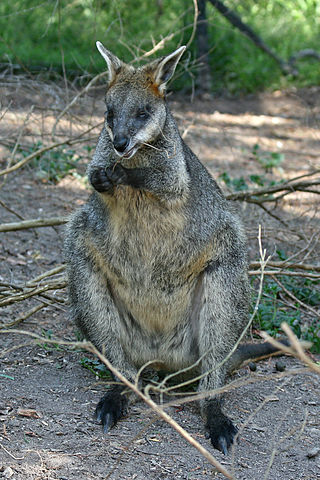
Macropodinae is a subfamily of marsupials in the family Macropodidae, which includes the kangaroos, wallabies, and related species. The subfamily includes about ten genera and at least 51 species. It includes all living members of the Macropodidae except for the banded hare-wallaby, the only surviving member of the subfamily Lagostrophinae.

Osphranter is a genus of large marsupials in the family Macropodidae, commonly known as kangaroos and wallaroos. It contains the largest extant marsupial, the red kangaroo.

The eastern short-eared rock-wallaby or Wilkins' rock-wallaby is a species of rock-wallaby found in the northernmost parts of the Northern Territory of Australia, and is common in the Kakadu and Litchfield National Parks. It was thought to be a subpopulation of the short-eared rock-wallaby Petrogale brachyotis found in the Kimberley, but recent genetic and morphological studies have shown it to be distinct. Wilkins' rock-wallaby is smaller, has more distinct grey/brown markings on its head and sides, and more colourful limbs than the western species.

